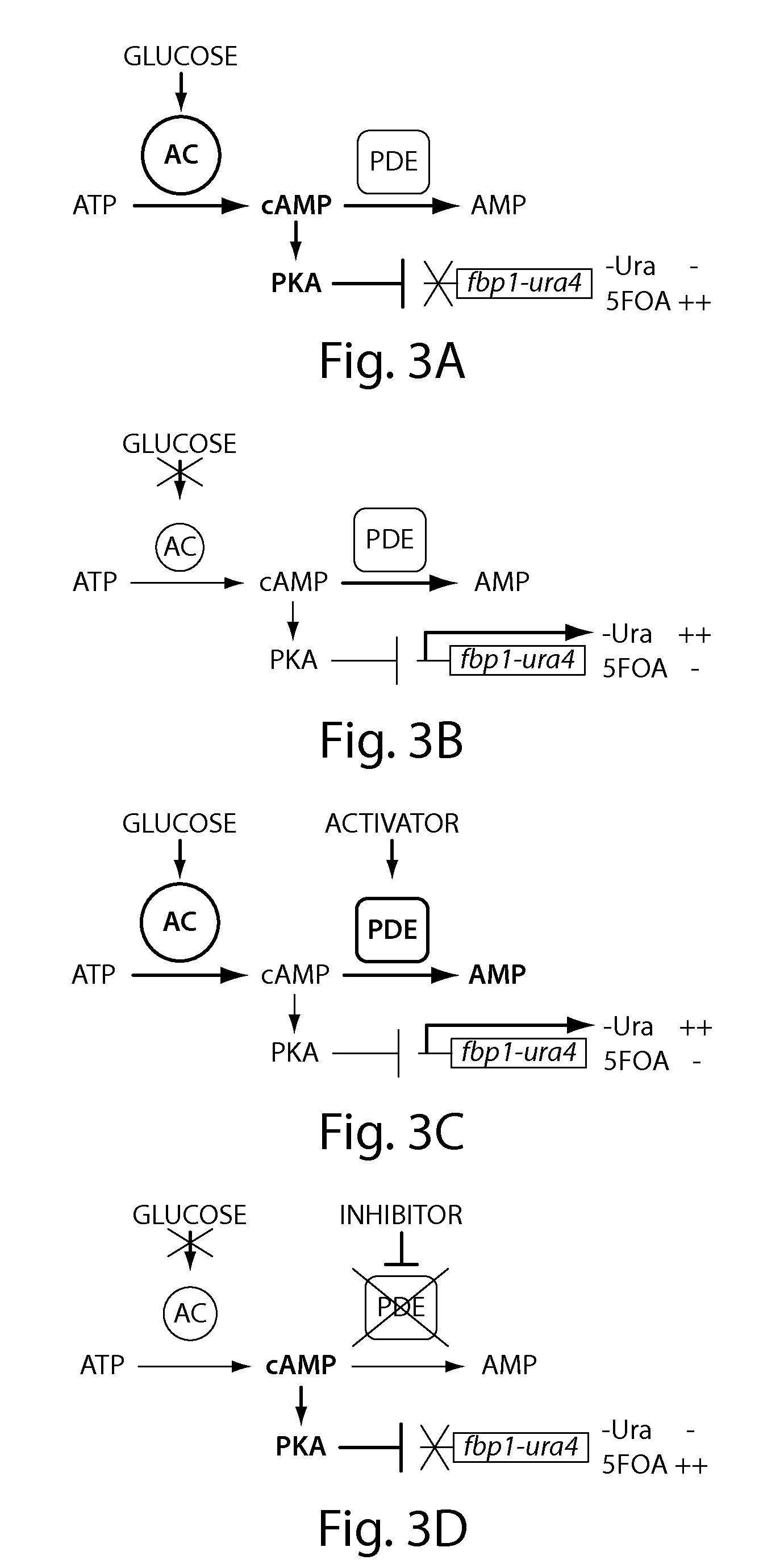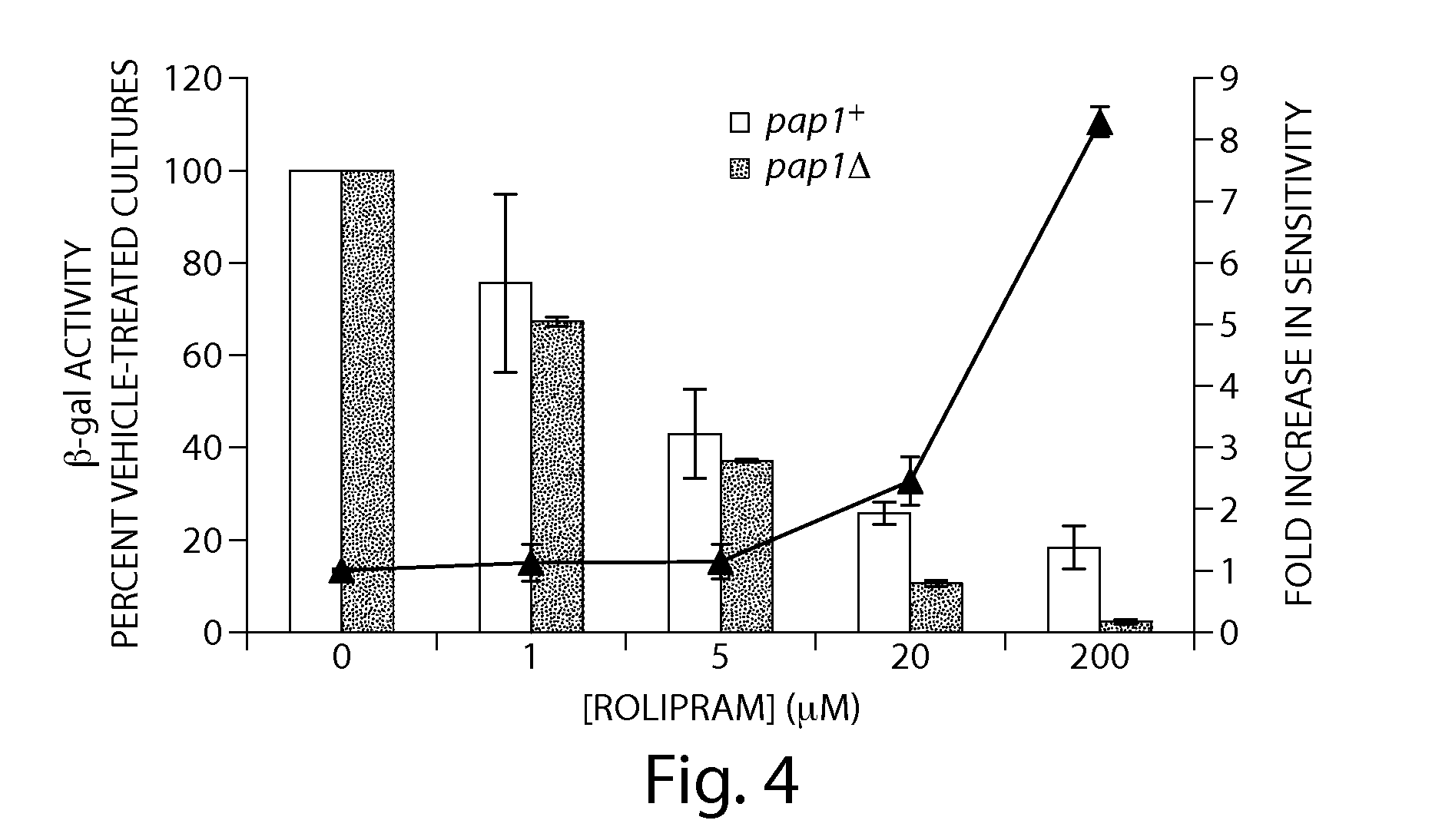Inhibitors of cyclic amp phosphodiesterases
a phosphodiesterase and cyclic amp phosphodiesterase technology, applied in the direction of biocide, immunological disorders, drug compositions, etc., can solve the problems of complicating efforts to determine the relative roles of specific enzymes, and achieve the effects of reducing toxicity and/or side effects, reducing pro-inflammatory cytokine production, and increasing therapeutic effectiveness
- Summary
- Abstract
- Description
- Claims
- Application Information
AI Technical Summary
Benefits of technology
Problems solved by technology
Method used
Image
Examples
example 1
Construction of a Recombinant Fission Yeast Strain Capable of Reporting Changes in cAMP Concentration
[0196]Translational fusions carrying the fbp1 promoter fused to the S. pombe ura4 and the E. coli lacZ reporter genes were prepared and used to monitor the cell's ability to detect glucose. See Hoffman, C. S. and F. Winston, Genetics, 1990, 124(4): p. 807-16. These constructs were integrated in single copy into the S. pombe genome, creating stable reporters of fbp1 transcription.
[0197]Fission yeast strains were spotted onto yeast extract agar supplemented with 2% casamino acids (YEA medium) and grown overnight. PDE activity was then assessed by replica plating the cells onto either YEA medium, synthetic complete (SC) solid medium containing 8% glucose and 0.4 g / L 5-fluorourotic acid (5FOA medium), or SC medium containing 8% glucose with no uracil (SC-Ura medium). For details, including β-galactosidase and cAMP assays, see Wang et al., Genetics, 2005, 171, p. 1523-33. The results are ...
example 2
Quantification of cAMP Levels Using Recombinant Fission Yeast
[0199]Wild type and two mutant strains (git1-1 and git2-7) having reduced cAMP levels were incubated overnight (18-24 hours) in EMM medium containing 5 mM cAMP to repress transcription of an fbp1-lacZ reporter construct from the fbp1 promoter and consequently repress β-galactosidase activity. Cyclic AMP was washed out by transferring the cells to EMM without cAMP at time 0. Washout of cAMP stimulated expression of β-galactosidase to an extent depending on the cellular machinery controlling cAMP levels. The results are shown in FIG. 2. The relative sensitivity of the mutant strains to 5FOA is shown in Table 2. The git1-1 strain, which was considerably more sensitive to 5FOA, yields the highest β-galactosidase activity after washout of cAMP in FIG. 2, demonstrating a semi-quantitative correlation between cAMP metabolism and cell growth in the presence of 5FOA.
TABLE 2Growth of S. pombe strains in 5FOA-containing mediumcorrela...
example 3
Use of a Recombinant Fission Yeast for High Throughput Screening for Chemical Inhibitors of PDE
[0200]Two 5FOA-sensitive strains are pregrown in the presence of 5 mM cAMP to repress transcription from the fbp1 promoter. Both strains possess the fbp1-ura4 and fbp1-lacZ reporter constructs. The experimental strain also expresses PDE4A1 in place of the yeast PDE. The control strain expresses the endogenous yeast PDE. Each strain is put individually into 384 well microtiter plates in a growth medium that contains 5FOA and 8% glucose, but no exogenous cAMP. These plates are used to screen a chemical library using robots that pin various compounds into the individual wells. If a compound has no effect on PDE activity or on any component of the yeast cAMP pathway, the cells of both strains deplete their cAMP leading to increased fbp1-ura4 transcription, which inhibits growth in the presence of 5FOA. If a compound stimulates cAMP production by targeting a component of the yeast cAMP pathway ...
PUM
| Property | Measurement | Unit |
|---|---|---|
| molecular weight | aaaaa | aaaaa |
| molecular weight | aaaaa | aaaaa |
| composition | aaaaa | aaaaa |
Abstract
Description
Claims
Application Information
 Login to View More
Login to View More - R&D
- Intellectual Property
- Life Sciences
- Materials
- Tech Scout
- Unparalleled Data Quality
- Higher Quality Content
- 60% Fewer Hallucinations
Browse by: Latest US Patents, China's latest patents, Technical Efficacy Thesaurus, Application Domain, Technology Topic, Popular Technical Reports.
© 2025 PatSnap. All rights reserved.Legal|Privacy policy|Modern Slavery Act Transparency Statement|Sitemap|About US| Contact US: help@patsnap.com



